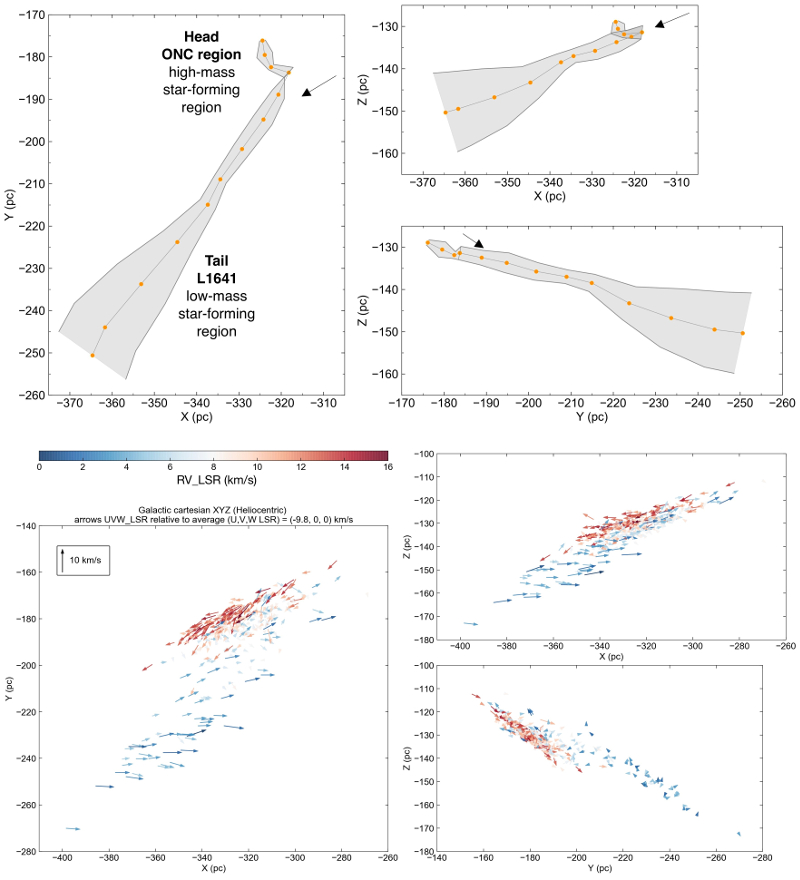| EPoS Contribution |
|
Orion A shape and dynamics with Gaia DR2: How 3D changes everything
Josefa Grossschedl U Viena, Wien, AT | |
| The GMCs in Orion have been extensively studied in the past, being the closest massive star-forming regions to Earth (~400 pc). Especially Orion A is often presented as the cluster and massive star formation benchmark, containing the famous Orion Nebula Cluster (ONC) toward the North ("head" of the cloud), and low-mass star-forming regions toward the South (L1641, hereafter "tail"). Recently, we used Gaia DR2 to reconstruct the cloud's 3D shape, using YSO parallaxes as proxy for cloud distances, to get an even better understanding for this important region. We find that the head of the cloud indeed lies at about 400pc, as expected, while the low-mass star-forming tail is, surprisingly, inclined about 70deg from the plane-of-the-sky, reaching almost 500pc towards the cloud's Southern end. Orion A is then an approximately 90 pc long filament (twice as long as previously assumed from projection), comet-shaped, with a "bent head" (see Fig). We suggest that this structure could have been caused by an external event ("push") in the past (feedback from massive stars, cloud-cloud collision), which could have been also responsible for the observed increased star formation rate (SFR) near the ONC. To further investigate this theory, we analyse the cloud's 3D dynamics using Gaia proper motions of YSOs and gas radial velocities from CO data (which are similar to YSO RVs from APOGEE). The dynamics support the "push" scenario, since regions near the ONC show a relative "backwards" motion compared to the low-mass parts (see Fig). Additionally, we include Orion B and some comet-shaped star-forming clumps in the south of Orion in our analysis and study them in a similar manner. Indeed, the 3D dynamics of the whole region seem to react coherently to some "push" of an external event that likely was located somewhere in-between or in-front of the MCs. Such an event could have originated from the slightly older OB associations that can be found in the region (one or several SNe). This new view of Orion is an example of how Gaia is opening a "3D window" on the topology and dynamics of the dense star-forming ISM, a critical missing ingredient in our understanding of star formation. | |
 | |
| Caption: Shape, orientation, and dynamics of the Orion A GMC, visualised in Galactic Cartesian coordinates (XYZ Heliocentric). Top: Cloud-shape as derived from averaged YSO distances (orange dots). The grey shaded area shows a possible extension of the cloud in 3D, derived from extinction contours. The black arrows indicate the line-of-sight from the Sun. The 3D shape reveals a "bent head", and an orientation of the cloud pointing toward the Galactic mid-plane. Bottom: Scatter-plot of YSOs with measured RVs (APOGEE) and parallaxes (Gaia). The arrows are cartesian velocity vectors, calculated relative to the average UVWLSR, colour-coded for RVLSR. The relatively "red-shifted" YSOs near the ONC seem to move "backwards", supporting a scenario where the head of the cloud was pushed by an external event. | |
| Collaborators: J. Alves, U Viena, AT G. Herbst-Kiss, U Viena, AT S. Meingast, U Viena, AT A. Hacar, U Leiden, NL C. Lada, CfA, US |
Key publication
Suggested Session: Molecular Clouds |

